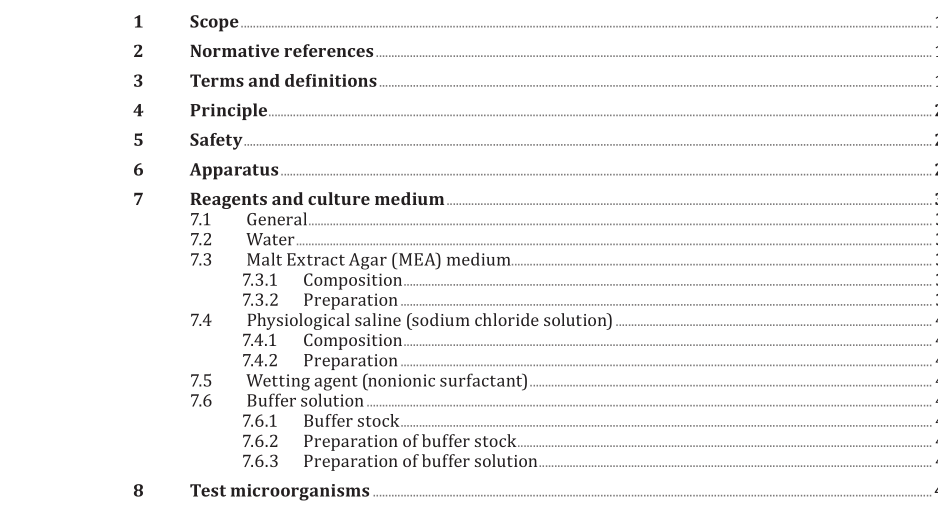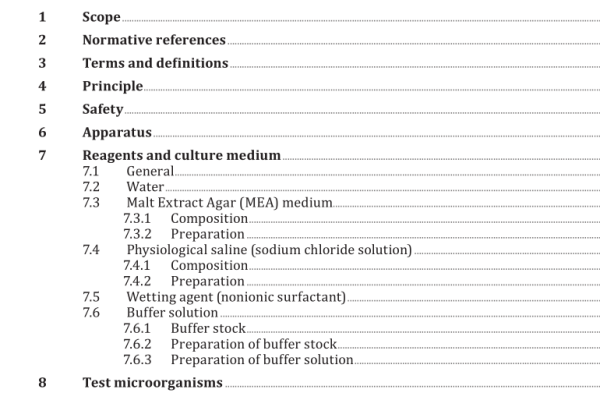ISO 19574:2022 pdf download – Footwear and footwear components — Qualitative test method to assess antifungal activity (growth test).
9 Preparation of test spore suspension 9.1? Apply strains within 4 generations. 9.2? Inoculate the micro-fungi spores onto the MEA medium (7.3) surface or standard PDA medium surface, and incubate at 28 °C ± 2 °C until the surface is full of micro-fungi spores (about 1 week to 2 weeks for Aspergillus sp./Penicillium sp. and 2 weeks to 3 weeks for Trichophyton sp.). 9.3? In each culture tube or plate, place 5 ml of physiological saline (7.4), and a non-toxic wetting agent (7.5) that may be added at a final concentration of 0,01 %. Gently scrape the surface of the sporulating culture with a sterile inoculation loop and introduce them into the culture tube or plate to obtain an aqueous suspension of the spores. Gently shake the culture tube or plate to disperse the spores in the liquid. Wash out spores and pour into a 125 ml sterile conical flask containing 10 sterile glass beads to 15 sterile glass beads (6.9). Repeat this procedure with the same culture plate twice. Shake the conical flask in order to get full uniform spore suspension. The spore suspension of each fungal culture is filtered at least twice through four thin layers of medical gauze or glass wool (6.10) to remove mycelia fragments, agar blocks and to separate combined spores. Aseptically centrifuge the filtered spore suspension under a relative centrifugal force of 2 000g for 1 min and discard the upper liquid. Re-suspend the residue in 20 ml physiological saline (7.4), and centrifuge again. Repeat washing of the spores for at least three times with this method and check by microscopy to ensure absence of mycelia fragments.
10 Preparation of test specimens 10.1? General Test only the components or materials that are claimed to be antifungal. If the whole footwear is claimed to be antifungal, major components, including upper, lining, insole, insock, outsole shall be tested separately. In the case where only one material of a component is claimed to be antifungal, it shall be tested separately, if possible. Otherwise, the whole component shall be tested. Each test specimen shall be at least 80 % of the surface area of the component or material. If a single material accounts for less than 80 %, take the two main materials used in the composition of the component. The test specimens can be obtained directly from the footwear or from components and materials prior to construction. 10.2? Test? and? control? specimens The area of test specimens should be about 1 600 mm 2 for testing, and have a thickness of less than 5,0 mm. The area and the weight shall be reported in the test report. If a larger test specimen is used, then the volume of micro-fungal suspension should be increased proportionally. If it is not possible to lower the thickness of the test specimens (for example, components are thicker and can’t be separated or cut without changing critical properties, such surface morphology, which can affect how the fungi interact with the surface), the thickness shall be indicated in the test report. Use material identical to the test material but without antifungal treatment as control specimens. If no such material is available, sterilized filter paper can be used as control specimens. At least three test specimens shall be taken for each material or component and three control specimens for each test.
ISO 19574:2022 pdf download – Footwear and footwear components — Qualitative test method to assess antifungal activity (growth test)






